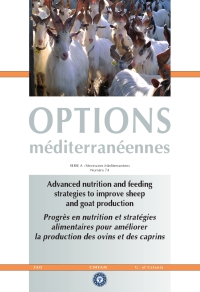| Article précédent | p. 123-127 | Article suivant |
Effect of nutrition-genotype interaction on protein and casein synthesis in goat milk of the Malagueña breed
An experiment was carried out using twelve goats of the Malagueña breed. Six of these animals belonged to the high capability (three BB and three AB) and six to the low capability (three FF and three EF) genotype for as1-casein synthesis. They were fed two different diets according particularly to their crude protein content: 13.6% (D1) and 17.7% (D2). Within each genotype, the animals were allocated to a 2x2 Latin square design with three repetitions. Together with the metabolizable energy intakes (kJ/kg0.75.d), the milk protein (g/kg0.75.d) and casein (g/kg0.75.d) synthesis were determined. From the corresponding results it was first inferred that the milk protein and casein synthesis depended on the metabolizable energy intake, these quantities being higher for the high capability genotype for as1-casein animals and for the higher protein content in the diet. The effects of genotype and protein content in the diet were mainly independent. So, one way of exploiting the genetic potential expression for milk protein and casein synthesis, could be to make use of diets with a high content of crude protein.
Nous avons réalisé une expérience avec douze chèvres de race Malagueña. Six d'entre elles appartenaient à un génotype de haute capacité et six à un génotype de faible capacité pour la synthèse de as1-caséine. Les animaux furent alimentés selon deux régimes différents quant au niveau de protéines : 13,6% (D1) et 17,7% (D2). Dans chaque génotype, les animaux furent répartis selon un carré latin 2x2 se répétant trois fois. En même temps que l'ingestion d'énergie métabolisable (g/kg0.75. jour) on a déterminé la synthèse de protéines (g/kg0.75. jour) et de caséines (g/kg0.75. jour) dans le lait. On a déduit des résultats obtenus comment la synthèse de protéines et de caséines dans le lait dépendait en premier lieu de l'ingestion d'énergie métabolisable, qui était plus élevée chez les animaux du groupe à haute capacité de synthèse de as1- caséine et faible consommation du régime le plus riche en protéine. Les effets du génotype et le niveau protéique du régime se trouvaient être des effets indépendants. Par conséquent, une manière d'exploiter le potentiel génétique concernant la synthèse de protéines et de caséines dans le lait, pourrait être d'utiliser un régime ayant une grande teneur en protéines.
- [ Afficher ]
- [ Télécharger ]
- [ Exporter la citation ]
Vous pouvez télécharger la citation au format :
- [ Imprimer ]
-
Mots-clés
CASEINE, CHEVRE, EXPERIMENTATION, GENOTYPE, PRODUCTION LAITIERE, PROTEINE, PROTEINE DU LAIT, REGIME ALIMENTAIRECiter cet article
De la Torre G., Serradilla J.M., Ares J.L., Rodríguez Osorio M., Sanz Sampelayo M.R. Effect of nutrition-genotype interaction on protein and casein synthesis in goat milk of the Malagueña breed. In : Priolo A. (ed.), Biondi L. (ed.), Ben Salem H. (ed.), Morand-Fehr P. (ed.). Advanced nutrition and feeding strategies to improve sheep and goat . Zaragoza : CIHEAM, 2007. p. 123-127. (Options Méditerranéennes : Série A. Séminaires Méditerranéens; n. 74). 11. Seminar of the FAO-CIHEAM Sub-Network on Sheep and Goat Nutrition, 2005/09/08-10, Catania (Italy). http://om.ciheam.org/om/pdf/a74/00800366.pdf



